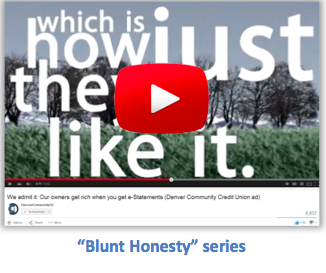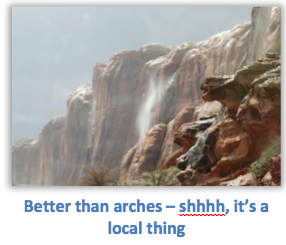Ego vs. ROI: Why a viral goal is wrong for your credit union brand

At a recent conference, the speaker pointed out a “viral” TD Canada YouTube video series with an Automated Thanking Machine. In this campaign, a (very expensive) fake ATM is filmed by a (very very expensive) camera crew from a (super expensive) agency as a customer is greeted by (an extremely expensive) Jose Bautista and invited to throw out the (ridiculously expensive) first pitch at a Blue Jays game. This is just one video in a series of many. Of course, the video was a viral hit, much like the famous WestJet Christmas Miracle campaign and the Banco Sabadell orchestra flashmob.
As marketers, we get excited about great brand messages like these, but there is a temptation to think that “going viral” is a good target for our own local brands. Aside from the extreme expense, which few if any brands in the conference room could match, it was easy to forget that the ad was being presented by an American presenter in a Las Vegas hotel to a bunch of industry fanboys & girls. In the whole room of 1,000+, not one person was likely to become a TD customer. I wondered how much of TD’s massive spend was reaching eyes just like mine: irrelevant ones.
EGO vs. ROI
In a way, “going viral” is much more about pride than good marketing. This is not a judgement of any brand or marketer, but self-reflection. In my interview for my current position, I highlighted a viral success of my own (ad 1, 2, 3) which earned 4,000 organic views overnight and quickly earned more than 24,000 total views with no promotion. I was, and am, very proud of them. But what I didn’t mention in that interview, mostly because it simply had not occurred to me at the time, was that almost none of these views were from a relevant audience.
The ads were voiced and directed by this guy, who has a loyal following of tens of thousands worldwide. (Let alone the US, let alone Colorado, let alone Denver county, let alone target) The ads were picked up by several industry pubs, so a whole bunch of credit union marketers were geeking out about them worldwide. (Let alone the US, let alone…) We even got emails from credit unions in New York, California, Canada and Scotland asking to borrow the material. Finally, there were thousands of views from the general public… worldwide.
Yay for Math!
 Let’s take our meager investment of $1,500 for the series. If we say the campaign earned 24,000 views, it’s only 6 cents per view! But if we remove 15,000 views from Jeff’s fan base, and another 4,000 from CU marketers, we’re left with 4,000 views. Still a respectable 37 cents per view. Now, consider that the rest might be evenly distributed across America’s 319 million people. All of the sudden, we’re left with just about 1 relevant viewer… me! No wonder I liked them! Apparently I spent $1,500 just to tickle my ego. If my field of membership reached as wide as TD’s, maybe I could justify the spend, but like most of my credit union peers, it doesn’t and I can’t.
Let’s take our meager investment of $1,500 for the series. If we say the campaign earned 24,000 views, it’s only 6 cents per view! But if we remove 15,000 views from Jeff’s fan base, and another 4,000 from CU marketers, we’re left with 4,000 views. Still a respectable 37 cents per view. Now, consider that the rest might be evenly distributed across America’s 319 million people. All of the sudden, we’re left with just about 1 relevant viewer… me! No wonder I liked them! Apparently I spent $1,500 just to tickle my ego. If my field of membership reached as wide as TD’s, maybe I could justify the spend, but like most of my credit union peers, it doesn’t and I can’t.
While these videos were created long before we had a built-in Facebook audience, which certainly would have reached a higher percentage of relevant viewers, it doesn’t change the fact that the “viral” nature of these ads did not produce nearly as many relevant viewers as a $10 boosted post of any video would have.
The Struggle is Real
The worldwide web is great at being, well, worldwide – but it isn’t good at being local. At least not for free. But even if there’s no value in going viral outside your market area, it’s at least a lot of fun – well, usually. Going viral stinks if it costs you lots of money.
To give an example outside of the realm of video, my credit union recently had our $150 bounty offer go “viral” when it was picked up by sites like FatWallet and SlickDeals. These sites show people how to get free money by opening and closing bounty accounts. We had people opening accounts from all over the country just to get $150.
Say that, of the general population, there are only .25% of people who have the time and enough screws loose to go through all of this work over the course of months just for $150. Of those, say 10% follow sites like FatWallet. Here’s how the numbers break down:
US population: (319M * .25%)*10% = 79,750 potential abusers
To limit the damage, we added a requirement to open your account in a branch. While the major damage had already been done, this move turned that math in our favor by excluding 99% of the US population, including many legitimate new accounts:
People near a branch: (13M * .25)*10% = 3,250 potential abusers
How to Make the World Wide Web Local
I loved seeing my work spread from person to person so quickly, and I think it is awesome that TD had such success. This article is not about why going viral is bad. To the contrary, it is great! But it shouldn’t be the goal. The goal should be to reach lots of relevant eyes with a tiny spend per relevant view.
Some tips to accomplish this:
Hire local college students and artists. They will be excited to post their work to their friends. If the average person has 338 “friends”, and we estimate 1/4 are relevant viewers, your spend on the local artist will reach 84 relevant viewers for free.
Engage your staff in content creation. If you involve 10 of your staff in a video shoot, and each share the completed project, you’ve reached 840 relevant eyes using the math above.
Find local landmarks that let locals know you’re in on the secret: For example, I grew up in Moab, UT and only locals know about the spectacular waterfalls after a rain. To be locally relevant, a Moab credit union could hire a photographer to photograph these waterfalls and distribute them on social media. Everyone else in the world wants to see arches, but people from Moab know that waterfalls are the true spectacle.
Partner with local businesses for cobranded content: Local businesses have local followers. Aside from the great publicity of aligning your brand with another local favorite, you’ll reach many relevant eyes when the business posts the content.









